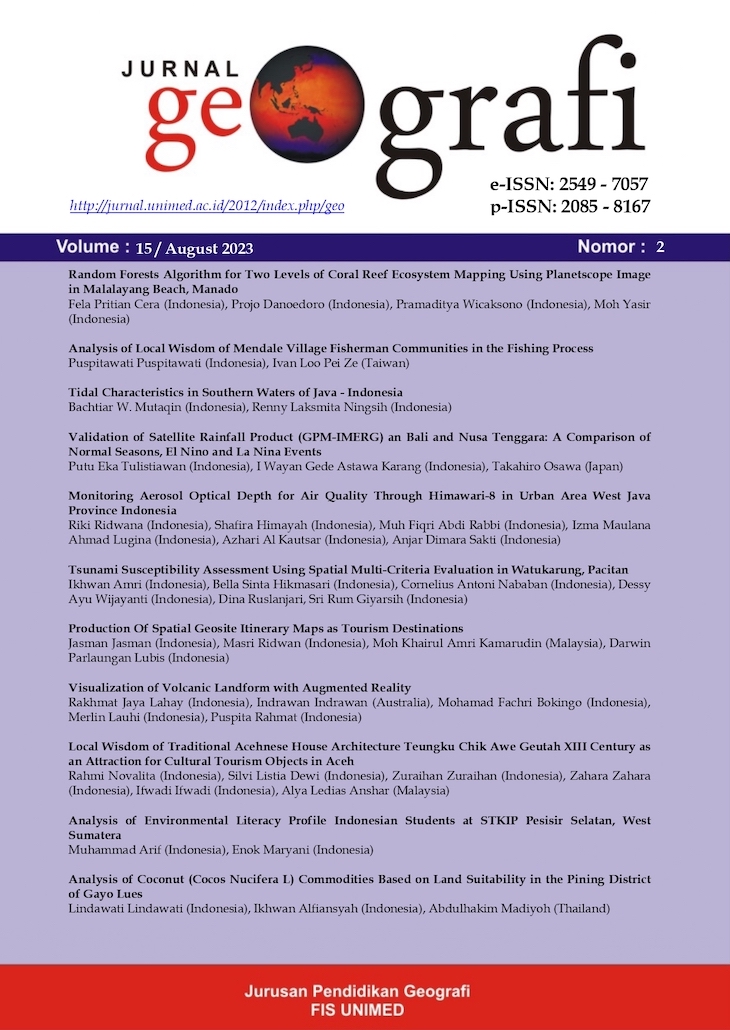Local Wisdom of Traditional Acehnese House Architecture Teungku Chik Awe Geutah XIII Century as an Attraction for Cultural Tourism Objects in Aceh
DOI:
https://doi.org/10.24114/jg.v15i2.45057Abstract
This study describes the local wisdom of Aceh's traditional house architecture and the potential for developing cultural tourism objects. This research method uses a qualitative approach. The research location is Awe Geutah Village, Peusangan Siblah Krueng District, Bireuen District, Aceh Province. The research informants are key informants, namely the managers of Acehnese traditional houses. This study also uses the principles of documentation, inventory, and tourism approaches”data analysis using data reduction, data display, and data reduction. The research results and the research update are the design of the Teungku Chik Awe Geutah Aceh traditional house model. This traditional Aceh house was built around the XIII century and has local wisdom in building construction that is sturdy and earthquake-resistant. The house plan consists of 3 parts: the front, middle, and rear. Each element in the traditional Aceh house has a philosophical meaning and a way of life for the people of Aceh. The potential for developing traditional Aceh houses is viewed from facilities and infrastructure, accommodation, accessibility, transportation, security, and hospitality. Keywords: Architecture, Local Wisdom, Cultural Tourism, Aceh HouseReferences
Bicker, A., Ellen, R., & Parkes, P. (2003). Indigenous environmental knowledge and its transformations: Critical anthropological perspectives. Routledge. https://doi.org/https://doi.org/10.4324/9780203479568
Boyer, M. C. (1994). The city of collective memory: its historical imagery and architectural entertainments (MIT Press, Ed.).
Ching, F. D., & Wardani, H. W. (2000). Arsitektur: Bentuk, Ruang dan Tatanan. Erlangga.
Dahliani. (2015). Local Wisdom Inbuilt Environment in Globalization Era. International Journal of Education and Research, 3(6).
Durie, Mark. (1984). A grammar of Acehnese (The Australian National University, Ed.; Australia).
Durmus, S. (2012). Change and Transformation in Architecture: On the Concept of Zeitgeist. Global Built Environment Review, 8(1).
Fakhirah, N., & Edytia, M. H. A. (2021). Sustainability concept as climate change adaptation in the vernacular house in Aceh. IOP Conference Series: Earth and Environmental Science, 881(1). https://doi.org/10.1088/1755-1315/881/1/012026
Gocer, O., Shrestha, P., Boyacioglu, D., Gocer, K., & Karahan, E. (2021). Rural gentrification of the ancient city of Assos (Behramkale) in Turkey. Journal of Rural Studies, 87. https://doi.org/https://doi.org/10.1016/j.jrurstud.2021.09.012
Hanan, H. (2010). Sustainability of the Traditional Form of Batak House in Samosir Island. Indigenous Architecture as Basic Architecture Design, 102“109.
Hasbi, R. (2012). Modul Sejarah Arsitektur Dunia. Universitas Mercubuana.
Iqbal, M., Fahrizal, E., & Selmi, H. (2019). Dokumentasi Rumah Aceh sebagai Upaya Pelestarian Arsitektur Tradisional Aceh (Studi Kasus: Rumah T. Tjhik Muhammad Said). Jurnal Lingkungan Binaan Indonesia, 8(2).
Izzah, Sari, L. H., Meutia, E., & Irwansyah, M. (2020). Traditional Acehnese House: Constructing Architecture by Responding to the Power of Nature in Relation to the Local Wisdom Values. Aceh International Journal of Science and Technology, 9(3). https://doi.org/https://doi.org/10.13170/aijst.9.3.17323.
Mardatillah, A. (2020). The enterprise culture heritage of Minangkabau cuisine, West Sumatra of Indonesia, is a source of sustainable competitive advantage. Journal of Ethnic Foods, 7(1), 34. https://link.springer.com/article/10.1186/s42779-020-00059-z.
Meutia, E., Rauzi, E. N., Sahputra, Z., & Maryana, D. (2021). The thermal comfort assessment of sustainable modifying Rumoh Aceh in hot humid climates. The 5th International Conference on Rebuilding Place, 881(1). https://doi.org/10.1088/1755-1315/881/1/012052.
Moleong, L. J. (2007). Metodelogi Penelitian Kualitatif Bandung. PT. Remaja Rosdakarya.
Muslimsyah, Munir, A., Away, Y., Abdullah, Huda, K., & Salsabilah, M. (2021). Assessment of indoor thermal environment of Aceh house based on WBGT index. The 5th International Conference on Rebuilding Place, 881(1). https://doi.org/10.1088/1755-1315/881/1/012023.
Novalita, R., Barlian, E., Muchtar, B., & Syah, N. (2018). Design a tourism awareness education module for Agam District, West Sumatra, tourism attraction managers. African Journal of Hospitality, Tourism and Leisure, 7(3).
Paasi, A. (2009). The resurgence of the 'region' and 'regional identity': Theoretical perspectives and empirical observations on regional dynamics in Europe. Review of International Studies, 35(S1), 121“146. https://doi.org/ttps://doi.org/10.1017/S0260210509008456
Pendit, N. S. (2002). Ilmu Pariwisata Sebuah Pengantar Perdana“Cet. 8 (Edisi Terbaru) dengan Perbaikan“Perbaikan. Penerbit Pradnya Paramita.
Philokyprou, M. (2015). Continuities and discontinuities in the vernacular architecture. Athens Journal of Architecture, 1(2), 111“120.
Rahmayati, Yenny. (2016). Post-disaster housing: Translating socio-cultural findings into usable design technical inputs. International Journal of Disaster Risk Reduction, 17. https://doi.org/https://doi.org/10.1016/j.ijdrr.2016.04.015.
Rapoport, A. (1969). House form and culture. Englewood Cliffs.
Sabila, F., & Rinawati, P. (2014). Tipologi tata ruang dalam rumoh Aceh di kawasan Mukim Aceh Lhee Sagoe. Arsitektur E-Journal, 7(1).
Sahputra, Z., & Edytia, M. H. A. (2021). A comparison study on the ornament of Rumoh Aceh in Aceh Besar and Umah Pitu Ruang in Aceh Tengah. Malaysian Journal of Sustainable Environment (MySE), 8(3). https://doi.org/https://doi.org/10.24191/myse.v8i1.12655.
Saputra, E., Mirsa, R., Yanti, P. D., Wulandari, & Husna, A. (2022). Eksplorasi Etnomatematika pada Arsitektur Rumoh Aceh. Aksioma: Jurnal Program Studi Pendidikan Matematika, 11(1). https://ojs.fkip.ummetro.ac.id/index.php/matematika/article/view/4751
Sawab, H., Shah, A., Lahna, K., & Ivan, T. (2021). The Thermal Phenomena of Aceh Traditional House Due to Changes Inform Spatial Planning, Building Materials, and Constructure Structures. The 5th International Conference on Rebuilding Place, 881(1). https://doi.org/10.1088/1755-1315/881/1/012042.
Sugiyono. (2017). Metode Penelitian Kuantitatif, Kualitatif, dan R&D. CV. Alfabeta.
Swarbrooke, J., & Page, S. J. (2012). Development and management of visitor attractions (Routledge, Ed.). Routledge.
Tantham, M., Hooghe, L., & Gary, M. (2021). The Territorial Architecture of Government. Governance, 34(3). https://doi.org/https://doi.org/10.1111/gove.12603.























